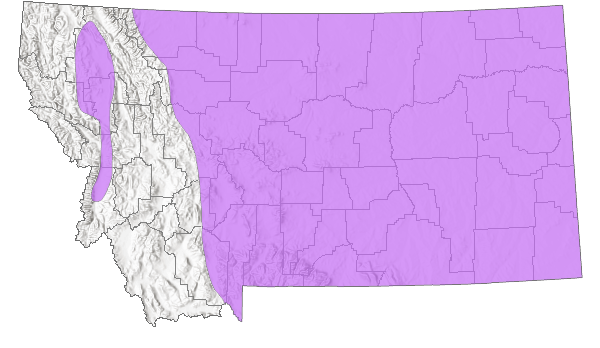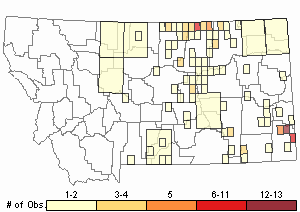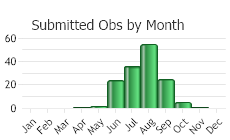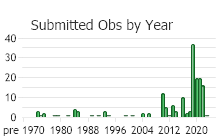View in other NatureServe Network Field Guides
NatureServe
Montana
Utah
Wyoming
Idaho
Wisconsin
British Columbia
South Carolina
Yukon
California
New York
Velvety Goldenrod - Solidago mollis
Native Species
Global Rank:
G5
State Rank:
S4
(see State Rank Reason below)
C-value:
4
Agency Status
USFWS:
USFS:
BLM:
External Links
State Rank Reason (see State Rank above)
Solidago mollis is present across most of Montana. More current data on population sizes and distributions is needed before warranting it as a Species of Concern.
- Details on Status Ranking and Review
Range Extent
ScoreG - 200,000-2,500,000 sq km (~80,000-1,000,000 sq mi)
Area of Occupancy
ScoreE - 26-125 4-km2 grid cells
Number of Populations
ScoreD - 81 - 300
Number of Occurrences or Percent Area with Good Viability / Ecological Integrity
ScoreC - Few (4-12) occurrences with excellent or good viability or ecological integrity
Environmental Specificity
ScoreD - Broad. Generalist or community with all key requirements common
Long-term Trend
ScoreU - Unknown
Trends
ScoreU - Unknown
Threats
ScoreU - Unknown
CommentThreats: Unknown/undetermined.
Intrinsic Vulnerability
ScoreC - Not intrinsically vulnerable
General Description
Plants: Perennial with a creeping rhizome (McGregor et al. 1986) and without a definite caudex (Hitchcock et al. 1955); herbage densely puberulent (Lesica 2012) throughout but may be almost glabrous near the stem’s base, grayish-green; stems one to a few, loosely clustered (McGregor et al. 1986).
Leaves: Thick, both surfaces canescent (covered with white or greyish hairs); basal leaves absent; the lower reduced cauline leaves falling early; the bigger mid-stem leaves abundant and crowded, scarcely to conspicuously reduced above, oval, lacking a petiole (or lower ones obovate with merely a hint of a petiole), 3–10 cm in length, 1-4 cm in width, the length 2 ½ to 5 times the width (Hitchcock et al. 1955), irregularly toothed to nearly entire (McGregor et al. 1986), the apex rounded or acute (Hitchcock et al. 1955), and the larger leaves conspicuously 3-nerved (McGregor et al. 1986).
Inflorescence & Heads: Inflorescence a dense, somewhat elongate panicle, or sometimes more compressed (McGregor et al. 1986), ovoid to conical with branches pointing toward one side. Involucres bell-shaped, 3–5 mm high; phyllaries lanceolate to oblanceolate (Lesica 2012), rounded or nearly acute (McGregor et al. 1986), ciliate (Lesica 2012) or glabrous, overlapping, typically 3.5-6 mm tall, the wider ones about 0.8-1.3 mm across (Hitchcock et al. 1955).
(Lesica’s contribution adapted from
Lesica et al. 2012. Manual of Montana Vascular Plants. BRIT Press. Fort Worth, TX)
Phenology
Flowers July-October (McGregor et al. 1986).
Diagnostic Characteristics
Unlike Velvety Goldenrod, the similar Rigid Goldenrod,
Solidago rigida, has basal leaves. It also has a branched caudex instead of rhizomes (
Lesica et al. 2012. Manual of Montana Vascular Plants. BRIT Press. Fort Worth, TX).
Species Range
Montana Range
Range Descriptions

 Native
Native
Range Comments
AB to MB south to NM, TX, IA and MI (Lesica et al. 2012. Manual of Montana Vascular Plants. BRIT Press. Fort Worth, TX).
Observations in Montana Natural Heritage Program Database
Number of Observations: 186
(Click on the following maps and charts to see full sized version)
Map Help and Descriptions
Relative Density

Recency



 (Observations spanning multiple months or years are excluded from time charts)
(Observations spanning multiple months or years are excluded from time charts)
Habitat
Dry or drying grasslands and meadows (McGregor et al. 1986), sagebrush steppe, coniferous woodlands; plains, valleys (Lesica 2012).
(Lesica’s contribution from
Lesica et al. 2012. Manual of Montana Vascular Plants. BRIT Press. Fort Worth, TX)
Ecology
POLLINATORS The following animal species have been reported as pollinators of this plant species or its genus where their geographic ranges overlap:
Bombus vagans,
Bombus appositus,
Bombus bifarius,
Bombus borealis,
Bombus fervidus,
Bombus flavifrons,
Bombus huntii,
Bombus melanopygus,
Bombus mixtus,
Bombus nevadensis,
Bombus rufocinctus,
Bombus ternarius,
Bombus terricola,
Bombus sitkensis,
Bombus occidentalis,
Bombus pensylvanicus,
Bombus bimaculatus,
Bombus griseocollis,
Bombus impatiens,
Bombus insularis,
Bombus suckleyi,
Bombus bohemicus,
Bombus flavidus, and
Bombus kirbiellus (Plath 1934, Heinrich 1976, Thorp et al. 1983, Johnson 1986, Shaw and Taylor 1986, Mayer et al. 2000, Colla and Dumesh 2010, Colla et al. 2011, Koch et al. 2012, Williams et al. 2014, Tripoldi and Szalanski 2015).
Reproductive Characteristics
Flowers: Ray florets fertile, yellow, 6 to 10 (commonly 8) (McGregor et al. 1986), 3-4 mm in length (Hitchcock et al. 1955); ligules 1–3 mm in length; disk flowers 3 to 8 (Lesica 2012), perfect and fertile (McGregor et al. 1986); corollas 2–5 mm in length (Lesica 2012).
Fruit: Achenes 1–2 mm in length, strigose (Lesica 2012) or appressed hairy; pappus of white capillary bristles (McGregor et al. 1986).
(Lesica’s contribution adapted from
Lesica et al. 2012. Manual of Montana Vascular Plants. BRIT Press. Fort Worth, TX)
Stewardship Responsibility
References
- Literature Cited AboveLegend:
 View Online Publication
View Online Publication Colla, S., L. Richardson, and P. Williams. 2011. Bumble bees of the eastern United States. Washington, DC: USDA Forest Service, Pollinator Partnership. 103 p.
Colla, S., L. Richardson, and P. Williams. 2011. Bumble bees of the eastern United States. Washington, DC: USDA Forest Service, Pollinator Partnership. 103 p. Colla, S.R. and S. Dumesh. 2010. The bumble bees of southern Ontario: notes on natural history and distribution. Journal of the Entomological Society of Ontario 141:39-68.
Colla, S.R. and S. Dumesh. 2010. The bumble bees of southern Ontario: notes on natural history and distribution. Journal of the Entomological Society of Ontario 141:39-68. Hitchcock, C.L. 1955. Compositae. In C.L. Hitchcock, A. Cronquist, M. Ownbey, and J.W. Thompson (eds.). Vascular Plants of the Pacific Northwest. Part 5: Compositae. Seattle, WA: University of Washington Press. 343 pp.
Hitchcock, C.L. 1955. Compositae. In C.L. Hitchcock, A. Cronquist, M. Ownbey, and J.W. Thompson (eds.). Vascular Plants of the Pacific Northwest. Part 5: Compositae. Seattle, WA: University of Washington Press. 343 pp. Johnson, R.A. 1986. Intraspecific resource partitioning in the bumble bees Bombus ternarius and B. pennsylvanicus. Ecology 67:133-138.
Johnson, R.A. 1986. Intraspecific resource partitioning in the bumble bees Bombus ternarius and B. pennsylvanicus. Ecology 67:133-138. Koch, J., J. Strange, and P. Williams. 2012. Bumble bees of the western United States. Washington, DC: USDA Forest Service, Pollinator Partnership. 143 p.
Koch, J., J. Strange, and P. Williams. 2012. Bumble bees of the western United States. Washington, DC: USDA Forest Service, Pollinator Partnership. 143 p. Lesica, P., M.T. Lavin, and P.F. Stickney. 2012. Manual of Montana Vascular Plants. Fort Worth, TX: BRIT Press. viii + 771 p.
Lesica, P., M.T. Lavin, and P.F. Stickney. 2012. Manual of Montana Vascular Plants. Fort Worth, TX: BRIT Press. viii + 771 p. Mayer, D.F., E.R. Miliczky, B.F. Finnigan, and C.A. Johnson. 2000. The bee fauna (Hymenoptera: Apoidea) of southeastern Washington. Journal of the Entomological Society of British Columbia 97: 25-31.
Mayer, D.F., E.R. Miliczky, B.F. Finnigan, and C.A. Johnson. 2000. The bee fauna (Hymenoptera: Apoidea) of southeastern Washington. Journal of the Entomological Society of British Columbia 97: 25-31. McGregor, R.L. (coordinator), T.M. Barkley, R.E. Brooks, and E.K. Schofield (eds). 1986. Flora of the Great Plains: Great Plains Flora Association. Lawrence, KS: Univ. Press Kansas. 1392 pp.
McGregor, R.L. (coordinator), T.M. Barkley, R.E. Brooks, and E.K. Schofield (eds). 1986. Flora of the Great Plains: Great Plains Flora Association. Lawrence, KS: Univ. Press Kansas. 1392 pp. Plath, O.E. 1934. Bumblebees and their ways. New York, NY: Macmillan Company. 201 p.
Plath, O.E. 1934. Bumblebees and their ways. New York, NY: Macmillan Company. 201 p. Shaw, D.C. and R.J. Taylor.1986. Pollination ecology of an alpine fell-field community in the North Cascades. Northwest Science 60:21-31.
Shaw, D.C. and R.J. Taylor.1986. Pollination ecology of an alpine fell-field community in the North Cascades. Northwest Science 60:21-31. Thorp, R.W., D.S. Horning, and L.L. Dunning. 1983. Bumble bees and cuckoo bumble bees of California (Hymenoptera: Apidae). Bulletin of the California Insect Survey 23:1-79.
Thorp, R.W., D.S. Horning, and L.L. Dunning. 1983. Bumble bees and cuckoo bumble bees of California (Hymenoptera: Apidae). Bulletin of the California Insect Survey 23:1-79. Tripoldi, A.D. and A.L. Szalanski. 2015. The bumble bees (Hymenoptera: Apidae: Bombus) of Arkansas, fifty years later. Journal of Melittology 50: doi: http://dx.doi.org/10.17161/jom.v0i50.4834
Tripoldi, A.D. and A.L. Szalanski. 2015. The bumble bees (Hymenoptera: Apidae: Bombus) of Arkansas, fifty years later. Journal of Melittology 50: doi: http://dx.doi.org/10.17161/jom.v0i50.4834 Williams, P., R. Thorp, L. Richardson, and S. Colla. 2014. Bumble Bees of North America. Princeton, NJ: Princeton University Press. 208 p.
Williams, P., R. Thorp, L. Richardson, and S. Colla. 2014. Bumble Bees of North America. Princeton, NJ: Princeton University Press. 208 p.
- Additional ReferencesLegend:
 View Online Publication
View Online Publication
Do you know of a citation we're missing? Adhikari, S. 2018. Impacts of dryland farming systems on biodiversity, plant-insect interactions, and ecosystem services. Ph.D. Dissertation. Bozeman, MT: Montana State University. 207 p.
Adhikari, S. 2018. Impacts of dryland farming systems on biodiversity, plant-insect interactions, and ecosystem services. Ph.D. Dissertation. Bozeman, MT: Montana State University. 207 p. Boggs, K. W. 1984. Succession in riparian communities of the lower Yellowstone River, Montana. M.S. Thesis. Montana State University, Bozeman, 107 pp.
Boggs, K. W. 1984. Succession in riparian communities of the lower Yellowstone River, Montana. M.S. Thesis. Montana State University, Bozeman, 107 pp. Britton, N. L. and A. B. Brown. 1913. An Illustrated Flora of the Northern United States, Canada, and the British Possessions. 2nd Edition in 3 Volumes. New York, NY: Charles Scribner's Sons. B13BRI01PAUS.
Britton, N. L. and A. B. Brown. 1913. An Illustrated Flora of the Northern United States, Canada, and the British Possessions. 2nd Edition in 3 Volumes. New York, NY: Charles Scribner's Sons. B13BRI01PAUS. DuBois, K.L. 1979. An inventory of the avifauna in the Long Pines of Southeastern Montana. M.Sc. Thesis. Bozeman, MT: Montana State University. 113 p.
DuBois, K.L. 1979. An inventory of the avifauna in the Long Pines of Southeastern Montana. M.Sc. Thesis. Bozeman, MT: Montana State University. 113 p. Eggers, M.J.S. 2005. Riparian vegetation of the Montana Yellowstone and cattle grazing impacts thereon. M.Sc. Thesis. Montana State University, Bozeman, MT. 125 p.
Eggers, M.J.S. 2005. Riparian vegetation of the Montana Yellowstone and cattle grazing impacts thereon. M.Sc. Thesis. Montana State University, Bozeman, MT. 125 p. King, L.A. 1980. Effects of topsoiling and other reclamation practices on nonseeded species establishment on surface mined land at Colstrip, Montana. M.Sc. Thesis. Bozeman, MT: Montana State University. 129 p.
King, L.A. 1980. Effects of topsoiling and other reclamation practices on nonseeded species establishment on surface mined land at Colstrip, Montana. M.Sc. Thesis. Bozeman, MT: Montana State University. 129 p. Law, D.J. 1999. A comparison of water table dynamics and soil texture under black cottonwood recent alluvial bar, beaked sedge, and Geyer's/Drummond's willow communities. M.Sc. Thesis. Bozeman, MT: Montana State University. 68 p.
Law, D.J. 1999. A comparison of water table dynamics and soil texture under black cottonwood recent alluvial bar, beaked sedge, and Geyer's/Drummond's willow communities. M.Sc. Thesis. Bozeman, MT: Montana State University. 68 p. Lesica, P., M.T. Lavin, and P.F. Stickney. 2022. Manual of Montana Vascular Plants, Second Edition. Fort Worth, TX: BRIT Press. viii + 779 p.
Lesica, P., M.T. Lavin, and P.F. Stickney. 2022. Manual of Montana Vascular Plants, Second Edition. Fort Worth, TX: BRIT Press. viii + 779 p. Maxwell, B.D. 1984. Changes in an infested plant community after an application of picloram, the effect of glyphosate on bud dormancy, the effect of pulling and the fuel potential of leafy spurge (Euphorbia esula L.). M.Sc. Thesis. Bozeman, MT: Montana State University. 73 p.
Maxwell, B.D. 1984. Changes in an infested plant community after an application of picloram, the effect of glyphosate on bud dormancy, the effect of pulling and the fuel potential of leafy spurge (Euphorbia esula L.). M.Sc. Thesis. Bozeman, MT: Montana State University. 73 p. Meier, G.A. 1997. The colonization of Montana roadsides by native and exotic plants. M.Sc. Thesis. Bozeman, MT: Montana State University. 45 p.
Meier, G.A. 1997. The colonization of Montana roadsides by native and exotic plants. M.Sc. Thesis. Bozeman, MT: Montana State University. 45 p. Peterson, J.G. 1969. The food habits and summer distribution of juvenile sage grouse in central Montana. M.Sc. Thesis. Bozeman, MT: Montana State University. 39 p.
Peterson, J.G. 1969. The food habits and summer distribution of juvenile sage grouse in central Montana. M.Sc. Thesis. Bozeman, MT: Montana State University. 39 p. Quire, R.L. 2013. The sagebrush steppe of Montana and southeastern Idaho shows evidence of high native plant diversity, stability, and resistance to the detrimental effects of nonnative plant species. M.Sc. Thesis. Bozeman, MT: Montana State University. 124 p.
Quire, R.L. 2013. The sagebrush steppe of Montana and southeastern Idaho shows evidence of high native plant diversity, stability, and resistance to the detrimental effects of nonnative plant species. M.Sc. Thesis. Bozeman, MT: Montana State University. 124 p. Rundquist, V.M. 1973. Avian ecology on stock ponds in two vegetational types in north-central Montana. Ph.D. Dissertation. Bozeman, MT: Montana State University. 112 p.
Rundquist, V.M. 1973. Avian ecology on stock ponds in two vegetational types in north-central Montana. Ph.D. Dissertation. Bozeman, MT: Montana State University. 112 p. Seipel, T.F. 2006. Plant species diversity in the sagebrush steppe of Montana. M.Sc. Thesis. Bozeman, MT: Montana State University. 87 p.
Seipel, T.F. 2006. Plant species diversity in the sagebrush steppe of Montana. M.Sc. Thesis. Bozeman, MT: Montana State University. 87 p. Skilbred, Chester L. 1979. Plant succession on five naturally revegetated strip-mined deposits at Colstrip, Montana. M.Sc. Thesis. Bozeman, MT: Montana State University. 128 pp.
Skilbred, Chester L. 1979. Plant succession on five naturally revegetated strip-mined deposits at Colstrip, Montana. M.Sc. Thesis. Bozeman, MT: Montana State University. 128 pp. Wiman, N.G. 2001. Dynamics of leafy spurge (Euphorbia esula L.) infested plant communities influenced by flea beetles in the Aphthona complex (Colepotera: Chrysomelidae). M.Sc. Thesis. Bozeman, MT: Montana State University. 148 p.
Wiman, N.G. 2001. Dynamics of leafy spurge (Euphorbia esula L.) infested plant communities influenced by flea beetles in the Aphthona complex (Colepotera: Chrysomelidae). M.Sc. Thesis. Bozeman, MT: Montana State University. 148 p. Wood, A.K. 1987. Ecology of a prairie mule deer population. Ph.D. Dissertation. Bozeman, MT: Montana State University. 205 p.
Wood, A.K. 1987. Ecology of a prairie mule deer population. Ph.D. Dissertation. Bozeman, MT: Montana State University. 205 p.
- Web Search Engines for Articles on "Velvety Goldenrod"





